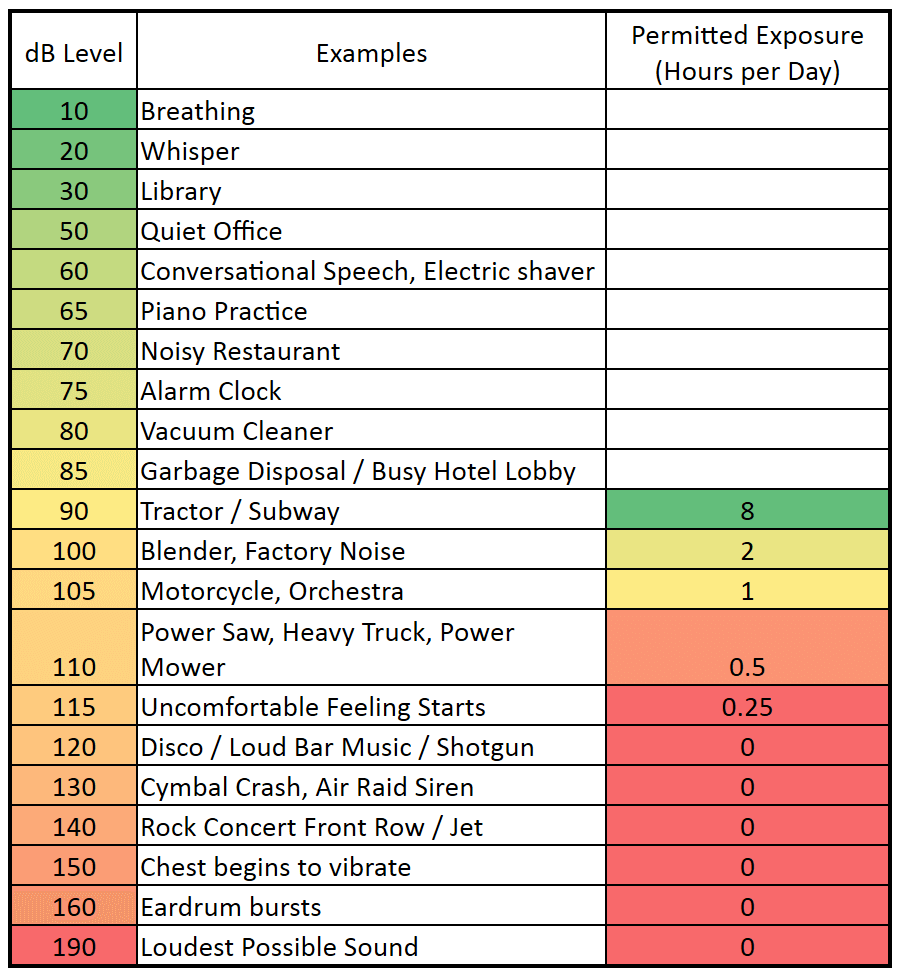How to select the speakers and the number required in your school

IP paging speaker placement and sound volume settings are key to providing clear sound in the school. Whether there is a general announcement or an emergency message, it’s important that the instructions can be heard and understood by everyone.
Network attached IP speakers are easy to install, but they must be placed in the right location, and the sound volume must be correct so that all locations are covered with clear sound.
This article provides guidelines for selecting the right IP paging speakers for your school. The article also helps you determine the number of speakers you need, and the amplification required.
Sound Level Required
To get some idea of the right sound level, here is a review of the sound levels we hear.
The sound level is measured in decibels or dB (or dBA). The dB level measures relative sound levels and is usually used to describe very loud sounds. The dBA measurement also measures the sound levels but at the frequency of 1000Hz which is the frequency most people can hear clearly.
The sound chart shows typical sound levels from different sources. It provides some indication of how long you can hear sound at a loud level.
Sound levels vary from “0” which is the lowest sound a person with good hearing can discern, to 190 dB which is the loudest possible sound. Very loud sounds can be hazardous to your ears. Any sound above 140dB can be painful. Hearing damage from sound is related to the loudness and duration of the sound. For example, it is recommended that you shouldn’t operate a chainsaw (with a sound level of 110 dB) for more than ½ hour a day. Government research says that 85 decibels is the maximum sound level for eight hours a day. Anything above that level requires ear protection.
From the chart above, we can see that the best sound level for our speakers is from 60 dB to about 85 dB. In some cases, we can provide sound levels above 85 dB, but for relatively short periods.
Sound Versus Distance
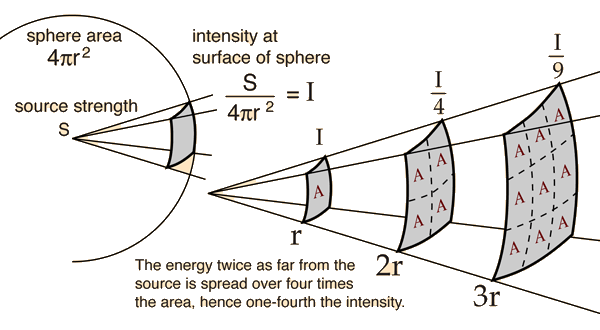
The sound level decreases as you move away from the speaker. That’s why it’s better to be in the back of the audience at a rock concert. If you want to be in the front row, wear ear protectors.
The sound level decreases based on the inverse square law. This is an idealized calculation because it doesn’t consider the reflections off surfaces or barriers that block the sound. The inverse square law is used for many different types of applications. For example, we also use this law to predict how much light will fall on an object that’s at a certain distance from the illuminator.
There are some calculators online that can be used to predict the sound level at a certain distance. You can also use a rule of thumb that predicts the sound level decreases by 6 dB for every doubling of the distance from the speaker. For example, if the speaker provides 90 dB of sound at 1m (3.28 ft.), at a distance of 2 m (6.56 ft.) the sound level is 84 dB (90 – 6 = 84).
Sound Level Versus Power
The sound level from a speaker is directly related to the input power of the signal. The sound level will increase by 3 dB for every doubling of power. If a speaker is rated at 100 dB at 1-watt, then it will provide 103 dB at 2-watts. If the power is increased to 4 watts, the sound level increases to 106 dB. Speakers also have a maximum sound level, so you can’t increase the power indefinitely. If the speaker has a maximum output of 120 dB, adding more power will only burn it out. We can also reduce the sound level by reducing the power.
Selecting a Speaker for the Classroom
The sound level in a school classroom depends on the background sound level. If the children are quiet, the sound level can be lower, but if the class is very noisy, we need more volume from our speakers. As a rule of thumb, the sound level from the speaker should be 10 dB above the background noise. The performance of a speaker is specified by their sound level at 1 meter away and using 1 watt of power. Let’s assume that we need a speaker with a maximum sound level of 83dB.

In many cases, a standard classroom requires only one speaker, but if it is a noisy room, an additional speaker can be added. A speaker can be placed on the ceiling or the wall. If we have a drop ceiling, it is very easy to install a speaker that’s made to fit in one of the ceiling panels.
For example, the Spkr-IP System12 fits in the drop ceiling. This PoE powered network attached speaker is specified at 92 dB at 1 meter, at 1 watt. Alternatively, we may decide to place a speaker on the wall. For example, the model SPKR-IP SYS 1HD wall speaker provides the same sound level as the ceiling speaker.
In many cases, a standard classroom requires only one speaker, but if it is a noisy room, an additional speaker can be added. A speaker can be placed on the ceiling or the wall. If we have a drop ceiling, it is very easy to install a speaker that’s made to fit in one of the ceiling panels. For example, the Spkr-IP System12 fits in the drop ceiling. This PoE powered network attached speaker is specified at 92 dB at 1 meter, at 1 watt. Alternatively, we may decide to place a speaker on the wall. For example, the model SPKR-IP SYS 1HD wall speaker provides the same sound level as the ceiling speaker.
Whatever speaker we select, we need to calculate how much power we need to apply to the speaker. The more power we use, the louder the sound. If we double the power, we increase the sound level by about 3 dB. We can also reduce the sound output by reducing the power level.
If the classroom is about 25 ft by 30 ft, we usually can use only one speaker in front of the room or one ceiling speakers. The height of the ceiling and the dispersal angle of the speaker will determine how many ceiling speakers we will need. The wider the dispersal angle of the ceiling speaker ceiling, the more coverage we get.
If the ceiling is 10 ft high, we estimate that the student’s ears are 4 to 5 ft from the floor or 5 to 6 ft (about 1.5 to 1.8 m) from the speaker, we can then determine the sound that they will hear. Using the sound distance rule, we calculate that at 2 meters, the sound level is 92 – 6 = 86 dB. If the classroom is usually quiet, we can decrease the sound level by reducing the power to the speaker. If we decrease the power to ½ watt then the sound level drops by 3dB to 83dB.
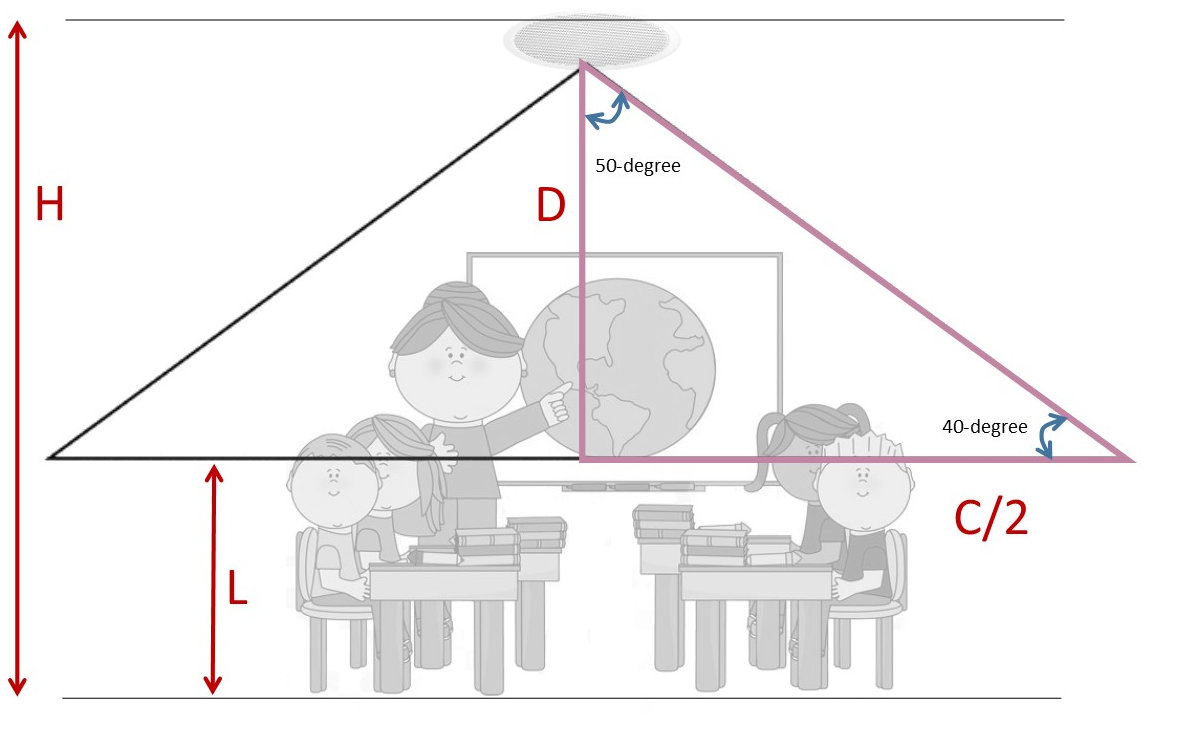
The speaker coverage is calculated using the ceiling height, the distance to the person’s ears and the angle of the speaker. For example, let’s assume the speaker has an angle of 100°. We use a triangle to calculate the coverage distance (C). We first draw a triangle with a 100-degree angle from the speaker.
Split the triangle into two 90-degree triangles with a top angle of 50-degrees.
The distance from the speaker to the ears of the students is equal to the height (H) of the room minus the distance from the floor to the ears (L) As we assumed before, the height of the room is 10 ft and the distance from the floor to the ears is 4ft, then the distance to the ears (D) is 6ft. Now we can calculate the opposite side of the triangle using a right-triangle calculator. The side C/2 equals 7.15 ft and C equals 14.3 ft. Since the sound reflects off the floor and walls, we actually get more coverage than the speaker angle predicts.
Speakers for a Large Room
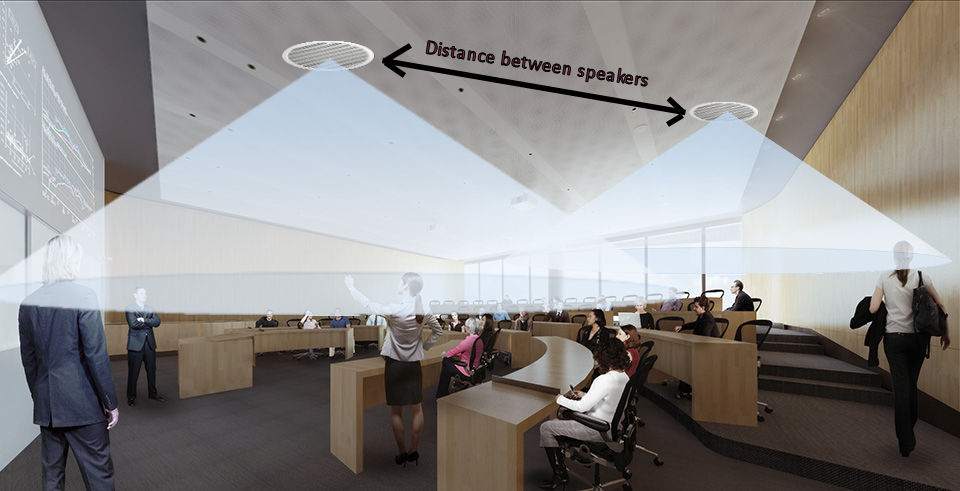
Larger rooms require more speakers. You can’t just increase the volume level. The number of speakers required depends on the size of the room, the height of the ceiling and the angle of coverage of the speakers. We can get a rough calculation of the number of speakers required by using the same coverage formula. The distance between speakers is about the same as the coverage distance.
As an example, if the ceiling is 16 ft high, the distance to the ears is 12 ft. The coverage distance and distance between speakers (with 100-degree angle) is calculated to be 14.3 x 2 = 28.6ft (or about 29 ft).
The total number of speakers required in a room is calculated by dividing the dimensions of the room by the speaker separation. For example, if the room is 80ft wide by 100ft long, we divide 80ft by 29 ft to get 2.76 speakers (about 3 speakers) in the wide direction. We divide 100ft by 29 ft and get 3.45 speakers (about 3 speakers), in the long dimension. Multiplying the two numbers, we calculate that the room should have about 9 speakers. We will also have to adjust the volume since the speakers are further away.
Selecting a speaker for the Hallway
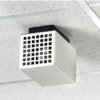
Hallway speakers can be placed on the ceiling or the wall. Dual speakers are available that project sound from the front and back. This means you can place the speaker in the center of a hallway and have sound projected both ways.
For example, the SPKR-IP-11-BD is a dual network attached speaker. It’s powered by PoE and can provide about 8-watts to the speaker. Since the speaker is rated at 92 dB at 1 watt, and at 1-meter, it provides more than enough sound level in a noisy hallway.
Speaker for Large Outdoor Area

A weather-proof horn speaker is used for large outdoor areas. The horn must be placed high enough so that the sound level is not too loud for people who are close.
The horn can provide very high sound output. For example, the model 132-8D horn provides over 110 dB at 1 watt at 1 meter. The speaker should be mounted higher than 13 ft. (4 m) so that the sound level close to the speaker doesn’t exceed 98dB. This speaker can be heard over 400 ft. (128 m) away.
A weather-proof horn speaker is used for large outdoor areas. The horn must be placed high enough so that the sound level is not too loud for people who are close.
The horn can provide very high sound output. For example, the model 132-8D horn provides over 110 dB at 1 watt at 1 meter. The speaker should be mounted higher than 13 ft. (4 m) so that the sound level close to the speaker doesn’t exceed 98dB. This speaker can be heard over 400 ft. (128 m) away.
Summary
The number of speakers required at the school depends on the area to be covered. If you have too few speakers, there will be points where the sound is very loud and other areas where the sound is too low. The more speakers, the better the sound distribution.
Historically paging systems used a large amplifier with a microphone. The speakers were wired to this central amplifier. It required quite a lot of work to wire everything together. It was difficult to adjust each of the speakers so that they would provide the right volume.
Today, paging systems utilize the existing local area network. All the speakers can be attached and powered over the network. The installation is much simpler and can be done by anyone who knows how to install a computer. The volume at each speaker can be adjusted from your computer.
If you would like help determining the type of speakers and their location, please contact us for assistance. We can be reached at 1-800-431-1658 in the USA, or at 914-944-3425 everywhere else, or use our contact form.
